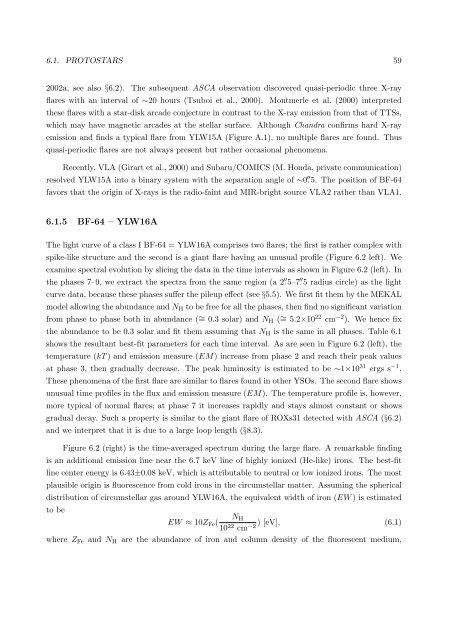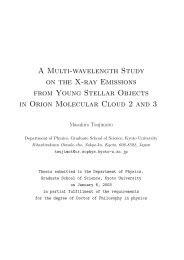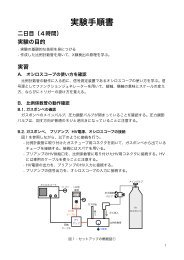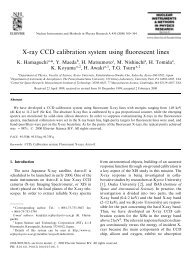X-ray Study of Low-mass Young Stellar Objects in the ρ Ophiuchi ...
X-ray Study of Low-mass Young Stellar Objects in the ρ Ophiuchi ...
X-ray Study of Low-mass Young Stellar Objects in the ρ Ophiuchi ...
You also want an ePaper? Increase the reach of your titles
YUMPU automatically turns print PDFs into web optimized ePapers that Google loves.
6.1. PROTOSTARS 592002a, see also §6.2). The subsequent ASCA observation discovered quasi-periodic three X-<strong>ray</strong>flares with an <strong>in</strong>terval <strong>of</strong> ∼20 hours (Tsuboi et al., 2000). Montmerle et al. (2000) <strong>in</strong>terpreted<strong>the</strong>se flares with a star-disk arcade conjecture <strong>in</strong> contrast to <strong>the</strong> X-<strong>ray</strong> emission from that <strong>of</strong> TTSs,which may have magnetic arcades at <strong>the</strong> stellar surface. Although Chandra confirms hard X-<strong>ray</strong>emission and f<strong>in</strong>ds a typical flare from YLW15A (Figure A.1), no multiple flares are found. Thusquasi-periodic flares are not always present but ra<strong>the</strong>r occasional phenomena.Recently, VLA (Girart et al., 2000) and Subaru/COMICS (M. Honda, private communication)resolved YLW15A <strong>in</strong>to a b<strong>in</strong>ary system with <strong>the</strong> separation angle <strong>of</strong> ∼0. ′′ 5. The position <strong>of</strong> BF-64favors that <strong>the</strong> orig<strong>in</strong> <strong>of</strong> X-<strong>ray</strong>s is <strong>the</strong> radio-fa<strong>in</strong>t and MIR-bright source VLA2 ra<strong>the</strong>r than VLA1.6.1.5 BF-64 – YLW16AThe light curve <strong>of</strong> a class I BF-64 = YLW16A comprises two flares; <strong>the</strong> first is ra<strong>the</strong>r complex withspike-like structure and <strong>the</strong> second is a giant flare hav<strong>in</strong>g an unusual pr<strong>of</strong>ile (Figure 6.2 left). Weexam<strong>in</strong>e spectral evolution by slic<strong>in</strong>g <strong>the</strong> data <strong>in</strong> <strong>the</strong> time <strong>in</strong>tervals as shown <strong>in</strong> Figure 6.2 (left). In<strong>the</strong> phases 7–9, we extract <strong>the</strong> spectra from <strong>the</strong> same region (a 2. ′′ 5–7. ′′ 5 radius circle) as <strong>the</strong> lightcurve data, because <strong>the</strong>se phases suffer <strong>the</strong> pileup effect (see §5.5). We first fit <strong>the</strong>m by <strong>the</strong> MEKALmodel allow<strong>in</strong>g <strong>the</strong> abundance and N H to be free for all <strong>the</strong> phases, <strong>the</strong>n f<strong>in</strong>d no significant variationfrom phase to phase both <strong>in</strong> abundance ( ∼ = 0.3 solar) and N H ( ∼ = 5.2×10 22 cm −2 ). We hence fix<strong>the</strong> abundance to be 0.3 solar and fit <strong>the</strong>m assum<strong>in</strong>g that N H is <strong>the</strong> same <strong>in</strong> all phases. Table 6.1shows <strong>the</strong> resultant best-fit parameters for each time <strong>in</strong>terval. As are seen <strong>in</strong> Figure 6.2 (left), <strong>the</strong>temperature (kT ) and emission measure (EM) <strong>in</strong>crease from phase 2 and reach <strong>the</strong>ir peak valuesat phase 3, <strong>the</strong>n gradually decrease. The peak lum<strong>in</strong>osity is estimated to be ∼1×10 31 ergs s −1 .These phenomena <strong>of</strong> <strong>the</strong> first flare are similar to flares found <strong>in</strong> o<strong>the</strong>r YSOs. The second flare showsunusual time pr<strong>of</strong>iles <strong>in</strong> <strong>the</strong> flux and emission measure (EM). The temperature pr<strong>of</strong>ile is, however,more typical <strong>of</strong> normal flares; at phase 7 it <strong>in</strong>creases rapidly and stays almost constant or showsgradual decay. Such a property is similar to <strong>the</strong> giant flare <strong>of</strong> ROXs31 detected with ASCA (§6.2)and we <strong>in</strong>terpret that it is due to a large loop length (§8.3).Figure 6.2 (right) is <strong>the</strong> time-averaged spectrum dur<strong>in</strong>g <strong>the</strong> large flare. A remarkable f<strong>in</strong>d<strong>in</strong>gis an additional emission l<strong>in</strong>e near <strong>the</strong> 6.7 keV l<strong>in</strong>e <strong>of</strong> highly ionized (He-like) irons. The best-fitl<strong>in</strong>e center energy is 6.43±0.08 keV, which is attributable to neutral or low ionized irons. The mostplausible orig<strong>in</strong> is fluorescence from cold irons <strong>in</strong> <strong>the</strong> circumstellar matter. Assum<strong>in</strong>g <strong>the</strong> sphericaldistribution <strong>of</strong> circumstellar gas around YLW16A, <strong>the</strong> equivalent width <strong>of</strong> iron (EW ) is estimatedto beEW ≈ 10Z Fe (10 22 ) [eV], (6.1)cm−2 where Z Fe and N H are <strong>the</strong> abundance <strong>of</strong> iron and column density <strong>of</strong> <strong>the</strong> fluorescent medium,N H

















